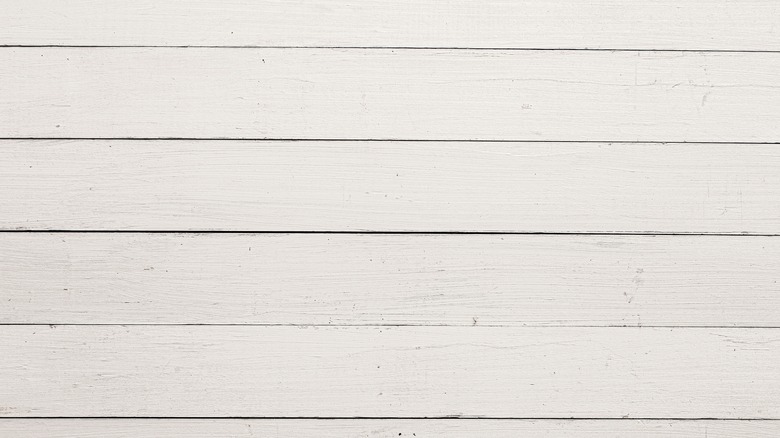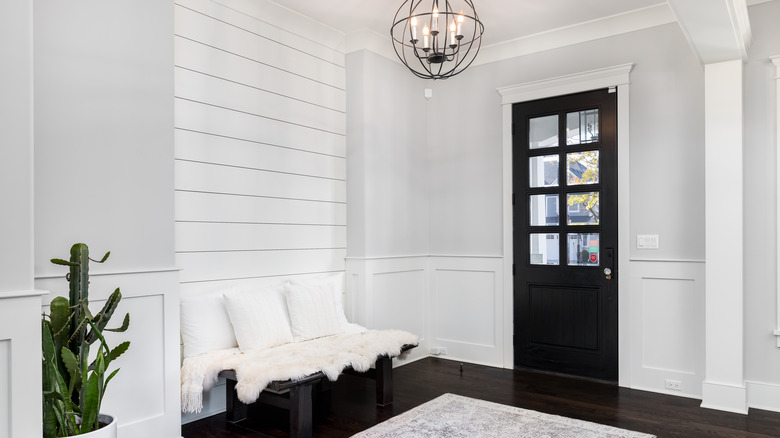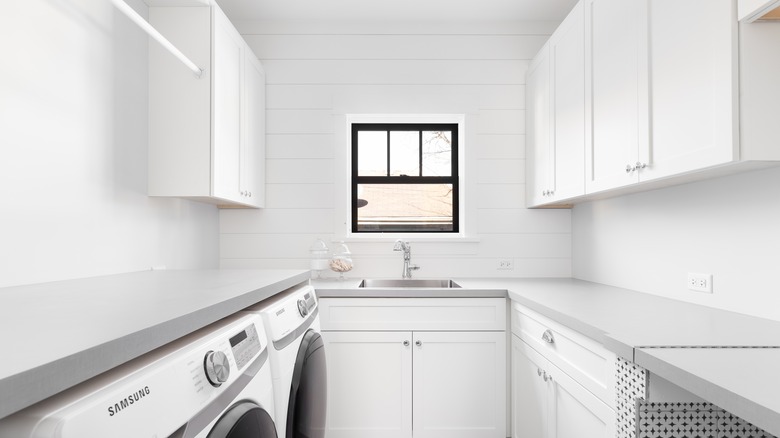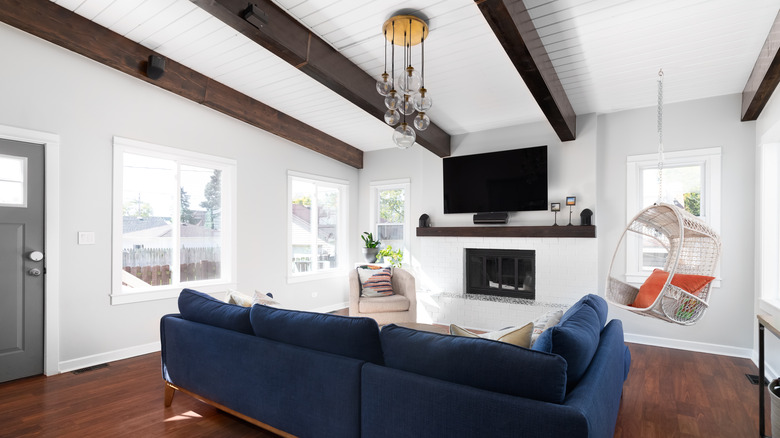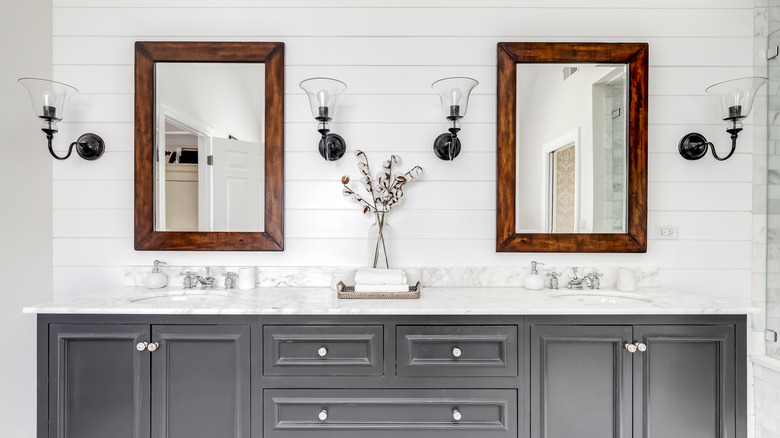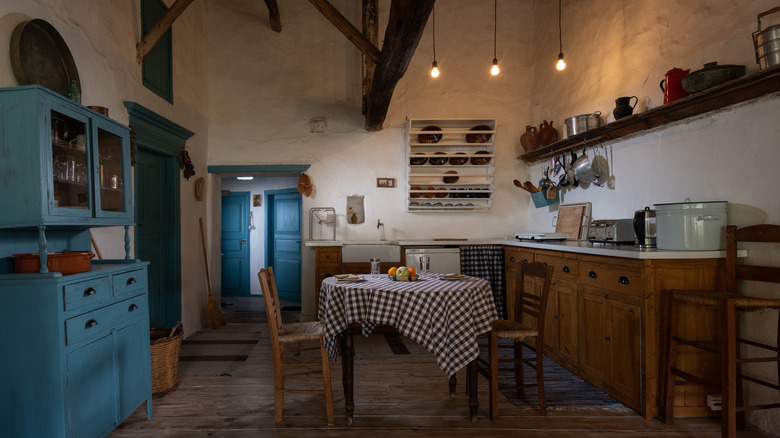5 Creative Places To Use Shiplap In Your Home
Shiplap is a wonderful visual element that can be added to the home in a number of versatile and easy-to-use ways. Historically, shiplap was a construction technique to create watertight siding on sailing vessels. The technique involves precision-cut grooves that slot into one another, creating a bond and natural seal between planks. This design element has made its way into decorative stylings in recent years, and it's easy to see why. In communities all across the world, you'd be hard-pressed to find a significant number of people who dislike the water, even in locations far removed from any coastal accessibility.
Nautical themes have always been a strong design choice in homes, office settings, and elsewhere, and the aesthetic has been much loved for centuries, according to Charm Patterns. Fortunately, shiplap is easy to install and won't require the same precision locking mechanisms that are a staple of this feature in its native shipbuilding. Instead, the shiplap design in the home is simply one that incorporates long planks placed in succession. This creates a rustic, nautical-type feel in any room of the house and can be used to great effect to build a new sense of luxury without breaking the bank.
Shiplap on an accent wall is a simple update brimming with potential
Perhaps the most often seen use of shiplap is in an accent wall for your living room or any other living space in the house. Simply put, this turns the idea of an accent wall on its head by changing not only the color of a corner or edge of the room but also the tactile feel of the wall. Aesthetically, shiplap introduces clean lines and a subtle relief against the backdrop of flat and sometimes dull standard walls. Installing shiplap along an accent wall is fairly simple as well.
Shiplap installations begin with a measurement of material needs. Defining the area of the space you'll be changing is the first job here and it starts with a decision to remove the baseboard and molding from the wall, or not. Many homeowners opt to remove these elements to create a flush fit for their shiplap installation (via Rambling Renovators), but you have complete control over the project, of course, and can leave these elements in place if desired or add them back on at the end of the project.
A shiplap wall does its best work when used in both color and texture changes from the rest of the room. In a dark room, a white or cream-colored shiplap addition can make a sizable impact; the same is true for a deep shade of gray or blue in a light room.
As a kitchen backsplash
One great area to use shiplap in the home is in the kitchen. Specifically, your kitchen backsplash can benefit immensely from the inclusion of shiplap elements. The backsplash is a highly visible element of any kitchen and, therefore, styling this piece of the room with a new shiplap installation can make for a high-impact inclusion.
To create a shiplap backsplash, you'll need to consider the general requirements of your kitchen space. Unlike in use as an accent wall for the living room or a bedroom, shiplap in the kitchen must be sealed with some kind of overleaf to protect the surface and cracks from oils, liquids, and other elements that are common in the kitchen space (via The RTA Store). However, as a backsplash, your shiplap installation will likely be much smaller than in other applications of this design feature. This means that time spent finishing the installation is balanced out with the far smaller installation timeline and material purchasing needs.
Ceiling adornment can transform a room's aesthetic
A shiplap ceiling element is another unique introduction that you can make to the property. Ceiling space is often underappreciated when it comes to renovation opportunities, and homeowners fail to realize the value of ceiling augmentation. For one thing, changing the way your ceiling appears can provide a stunning visual element to the overall room. But where these additions do their best work is in the evening light. For the most part, the lights in your home face upward, illuminating the ceiling as a rule rather than the exception. What shiplap installations on the ceiling can do for lighting is create a unique bounce pattern that changes the way your bulbs interact with the room's dimensions more broadly. Strobist notes that modern home design already involves consideration of the bounce patterns of light, but this feature can easily be overlooked.
Shiplap ceilings have become a major design feature in homes across the country and for good reason. Shiplap installations on the roof are also easy to complete. In the same way that homeowners don't typically think of their ceiling space in design terms, they also don't incorporate decorations on ceilings. This makes the ceiling a blank slate that can be altered without having to remove picture frames, shelves, and other elements in an effort to prepare the surface for a new look.
In the bathroom, shiplap creates a nautical feel
Bathrooms can benefit immensely from the installation of shiplap, too. The bathroom is one of the spaces in your home that you use more often than any other area (via Daily Infographic). Yet, bathrooms often go underappreciated just like some of these other components of a typical property. Setting the mood in your bathroom is all about creating a relaxing environment that sets the day off on the right path.
Given the context, shiplap is a great option for any bathroom. The wooden texture, smooth and flowing lines, and unique design change that shiplap brings to the table can make for a fantastic backdrop to your morning routine. However, in the same way that shiplap must be protected if used in the kitchen, it must be sealed for bathroom use as well. Bathrooms experience considerable amounts of moisture, so you'll need to protect this wall design in order to get the most out of it.
Furniture siding can benefit from shiplap design as well
Lastly, shiplap can make a great impact on the furniture in your home. A kitchen island, end table, or even a desk or TV stand can be elevated with the incorporation of a shiplap pattern. This makes shiplap a great installation across multiple different rooms and spaces of the home.
Refurbishing furniture is often something that homeowners fail to bring into their maintenance routines. As a TV stand or desk begins to show signs of its age, many homeowners simply scour the market for a replacement. But this is a great way to overpay for something that you don't need to; Midwest Life and Style notes that simple refurbishment options are widely accessible, regardless of your individual skill and confidence level. Instead, using shiplap as a means to restore an outdated piece of furniture can give you a cost-effective and beautifying solution to the problem.
Perhaps the best part of using shiplap in this way is that it requires far less precision than in other applications. When installing shiplap along the ceiling or a wall in your home, the dimensions must be perfect, and every piece must sit flush. This often translates into increased preparation time but in contrast, refurbishing old furniture with the use of shiplap typically requires just sanding or the removal of certain material on the unit. At the end of the day, you gain a brand new piece of furniture that looks dramatically different than the old unit.
